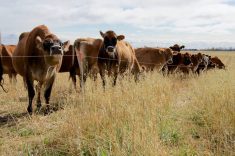KANANASKIS, Alta. – Political apathy is seen by many as the strongest barrier against wind power development in Canada.
While the last federal budget granted some tax concessions to alternative energy projects, inertia is evident in the industry as it struggles for recognition.
To further develop green power, the federal government agreed last January to try alternative power sources in a series of pilot projects as part of its international commitment to lower carbon dioxide emissions.
Green power is electricity generated from renewable energy sources like wind or solar power that don’t contribute to greenhouse gas emissions.
Read Also

U.S. cattle producers fear return of screwworm
Parasitic screwworm flies are pushing northward from Central America again after being officially eradicated from the United States in 1966, threatening $1.8 billion in damage to Texas’ economy alone.
Jeff Passmore, president of the Canadian Wind Energy Association, said there is embarrassment among wind energy proponents in this country over the lack of activity.
Not only do politicians remain apathetic, but the public doesn’t know alternative energy programs like wind are viable, he said in an interview at the Kananaskis wind energy conference.
Small projects are running across the country, but none were started last year and none are expected to begin in 1996. None of these generate enough power to make a difference, even though supporters claim Canada could capture the wind and produce 6,000 megawatts of electricity annually.
Wind energy is taking off in Europe and the United States. Further, countries like the Netherlands, Denmark and Germany are becoming leaders in the manufacture and export of wind turbines. Germany installed about 1,000 wind turbines in 1995, said Passmore.
“The political leadership there has taken the initiative and said this is something that matters and we are concerned about the environment,” said Passmore.
Lack of incentive
In a country rich in fossil fuels, there is little incentive in Canada to build renewable energy bases like wind, ethanol or solar power. There is minor technology development or very little attention is paid to the environmental benefits of using clean energy.
Another problem is that public utilities like electricity have been held by monopolies which have no interest in promoting other forms of power.
“Because we haven’t taken alternative energy sources seriously, we haven’t created any jobs or are getting any of the environmental benefits,” Passmore said.
“We’re not even an international player when it comes to the export opportunities that comes with that activity.”
The bright spot for Canada is southwestern Alberta. This is Canada’s windiest region where powerful chinooks blow across the Rocky Mountains nearly every day. What many regard as a nuisance could gain some respectability, he said.
The Cowley Ridge wind farm near Pincher Creek, Alta. is gaining attention and a number of farmers and ranchers use wind turbines and solar panels for on farm power generation.















